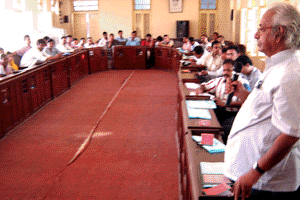|
CCD
Activities:
Dialogue
on Community Journalism
95%
Indigenous People Deprived of Education in Northern Region
Pabna,
September 27:
95%
of the indigenous people living in the northern region are deprived of
education and lack of education is the main cause of their poverty and
backwardness.
 It
was opined in the dialogue on Role of Journalists in Raising Indigenous
People’s Voice held at the District Council Auditorium in Pabna today.
With the support of WACC, mass communication oriented development
organization CCD Bangladesh organized this dialogue. Speakers also said,
there prevails a negative attitude to the children of the indigenous people
in the educational institutions and they are discouraged at education there.
Actually, due to poverty and social negligence towards them, 95% of the
indigenous children are dropout from education. Consequently, literacy rate
is not increasing among them. Though some development organizations have
taken initiative to educate them in their own language, it is yet to be
satisfactory in this region. Speakers, therefore, stressed on educating them
for socio-economic development of the backward saontal and other aboriginal
communities. It
was opined in the dialogue on Role of Journalists in Raising Indigenous
People’s Voice held at the District Council Auditorium in Pabna today.
With the support of WACC, mass communication oriented development
organization CCD Bangladesh organized this dialogue. Speakers also said,
there prevails a negative attitude to the children of the indigenous people
in the educational institutions and they are discouraged at education there.
Actually, due to poverty and social negligence towards them, 95% of the
indigenous children are dropout from education. Consequently, literacy rate
is not increasing among them. Though some development organizations have
taken initiative to educate them in their own language, it is yet to be
satisfactory in this region. Speakers, therefore, stressed on educating them
for socio-economic development of the backward saontal and other aboriginal
communities.
The
problems and potential of the indigenous people living in Pabna in respect
to their economy, education, culture, politics and environment and the role
of journalists to uphold these issues were chalked out in the dialogue.
Assistant
Professor of Mass Communication Department of Rajshahi University Dulal
Chandra Biswas facilitated the dialogue. Director of CCD Bangladesh G M
Mourtoza, Regional Coordinator in Pabna Faruk Hossain Chowdhury and Program
Coordinator A H M Abdul Hai presented welcome address. Representatives of
local and national newspapers and delegates from indigenous communities and
NGOs working for the welfare of the indigenous people actively took part in
the dialogue.
News/Feature/Article:
Mother
Tongue at Stake!
Mustafa
Zaman:
Twenty
years ago Menlay Murang, a Mro by descent, introduced a new religion. He
called his faith Crama. According to Shourav Sikder, an assistant professor
of Linguistics in Dhaka University who conducted an extensive research on
the languages of the indigenous people living in Bangladesh, the new faith
emerged by compounding Christian beliefs with the existing animistic
practices of the Mro people. Menlay's vision was not confined to the spread
of his religion. He created the opportunity to make his people literate in
their mother tongue. He is the man who has given his own people Mro
alphabets.
Menlay
established a learning centre in his own village in 1986, which he called
Mro Cha Sangra, meaning Mro learning centre. It was later destroyed in the
devastating cyclone of 1991, and Menlay could not rebuild his school. So, he
failed to continue his effort thereafter.
 Among
the fifty indigenous groups of people that inhabit Bangladesh Mros have had
better luck in ensuring education of their offspring in their own language.
They have text books up to class three in Mro. It is an achievement that
many other Adivasi groups would be envious of. Among
the fifty indigenous groups of people that inhabit Bangladesh Mros have had
better luck in ensuring education of their offspring in their own language.
They have text books up to class three in Mro. It is an achievement that
many other Adivasi groups would be envious of.
Many
of these Mro text books emphasise the fact that the Mro alphabet originally
stemmed from Roman, Burmese, and Sino sources. It also acknowledges the debt
to a Mro named Menrum Mro who invented a Mro font in 1996 called Rien. The
books, brought out by a committee on behalf of the Mro community with the
help of Gonoshastho Kendra, are written in the alphabets invented by the
Menlay.
"The
proposition to provide education to all the indigenous groups in their own
language is almost an impossible one at present, as most do not have their
own written script. Those who don't have alphabets of their own are also
divided over whether to adopt Roman or Bangla script when it comes to
forging a written form of their own language," says Sikder. He speaks
of a similar divide among the Santals. "Among them the ones who
converted to Christianity prefer Roman alphabet to the Bangla script. The
rest are willing to adopt Bangla alphabets in written expression of Santali,
their language," Sikder clarifies.
Read
more at http://www.thedailystar.net/magazine/2006/02/03/cover.htm
|